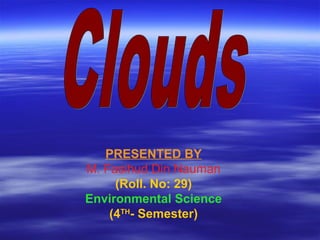
Ppp on clouds and their classification
- 1. PRESENTED BY M. Fasihud Din Nauman (Roll. No: 29) Environmental Science (4TH- Semester)
- 2. Clouds visible mass of liquid droplets or frozen crystals made of water and/or aerosols is called cloud.
- 3. Cloud Location Majority of clouds form in the TROPOSPHERE Clouds can be observed in STRATOSPHERE and MESOSPHERE Three layers of atmosphere collectively called HOMOSPHERE where clouds are present Clouds are absent in the HETROSPHERE (Thermosphere and Exosphere)
- 4. CLOUD FORMATION Warm air is forced upward, expands then cools. As air cools the amount of water vapor needed for saturation decreases (RH then increases). RH of 100%, air is saturated Water vapor begins to condense in tiny drops around nuclei of dust, salt, and other particles. Drops of water are so small they are suspended in air. Millions of these droplets collect forming clouds.
- 5. CLOUDS CLASSIFICATION There are following components which summarize the classification system. ♣ Cirro : curl of hair, high ♣ Alto : mid ♣ Strato : layer ♣ Nimbo : rain, precipitation ♣ Cumulo: heap
- 6. CLOUD CLASSIFICATION •Clouds are classified by texture and height from the ground. SHAPE Cumulus : cotton ball shaped Stratus : forms a blanket over large areas. Cirrus : feathery or wispy
- 7. 4 Major families of Clouds A. High Clouds : above 5-13 km. B. Middle Clouds : 2-7 km. C. Low Clouds : 0-2 km. D. Clouds with vertical development (0-13 km)
- 8. Cloud Types
- 9. TYPES OF CLOUDS ♦ High-level clouds: ♣ cirrus ♣ cirrostratus ♣ cirrocumulus ♦ Mid-level clouds: ♣ altostratus ♣ altocumulus ♦ Low-level clouds: ♣ stratus ♣ cumulus
- 11. High Clouds (Family A) Composed of ice crystals (Cirrostratus) Thin and wispy (Cirrus)
- 12. High Clouds Cont… High-level clouds form above 6 km The temperatures are so cold at such high elevations, these clouds are primarily composed of ice crystals. High-level clouds are typically thin and white in appearance, but can appear in a magnificent array of colors when the sun is low on the horizon.
- 13. CIRRUS Thin, featherlike clouds that are made of ice crystals high in the atmosphere. Usually means a change in the weather is coming.
- 14. High Clouds Cont… Cirrus (Thin and wispy) The most common form of high-level clouds are thin and often wispy cirrus clouds. Typically found at heights greater than 20,000 feet (6,000 meters) cirrus clouds are composed of ice crystals that originate from the freezing of supercooled water droplets. Cirrus generally occur in fair weather and point in the direction of air movement at their
- 15. CIRROSTRATUS
- 16. CIRROSTRATUS Cirrostratus clouds form more of a widespread, veil-like layer. When moon or sun light passes through the ice crystals of cirrostratus clouds, the light may dispersed.
- 17. High Clouds Cont… Cirrostratus (nearly transparent) Sheet-like, clouds composed of ice crystals. Though cirrostratus can cover the entire sky and be up to several thousand feet thick They are relatively transparent, as the sun or the moon can easily be seen through them. These high-level clouds typically form when a broad layer of air is lifted by large-scale Convergence Its presence indicates a large amount of moisture in the upper atmosphere These are not precipitation clouds, but signal the approach of warm front
- 18. CIRROCUMULUS
- 19. High Clouds Cont… Cirrocumulus (Cloudlets) (Cc) Typically found at heights 5 to 12 km. These clouds signify convection It includes . Cirrocumulus usually only forms in patches
- 20. MID-LEVEL CLOUDS
- 21. Mid-Level Clouds Composed of water droplets and ice crystals
- 22. ALTOSTRATUS
- 23. ALTOSTRATUS CLOUDS Altostratus clouds “strato” type clouds having flat and uniform type texture. Altostratus clouds themselves do not produce precipitation at the surface. They frequently indicate warm wave front.
- 25. LOW-LEVEL CLOUDS
- 26. Low-Level Clouds Composed mostly of water droplets
- 28. STRATUS Sheets of low, grey clouds that bring light snow, rain, or drizzle.
- 29. NIMBOSTRATUS
- 30. NIMBOSTRATUS Thicker layer than stratus clouds that completely block out the sun. They cause steady rain or snow.
- 32. CUMULUS White and puffy clouds that usually mean good weather.
- 33. CUMULONIMBUS
- 34. CUMULONIMBUS Dark, towering clouds that are also called “thunderheads”. These clouds produce heavy rain, thunderstorm, and lighting.
- 35. Cumulonimbus
- 36. PRECIPITATION Process by which water falls to Earth from clouds in the atmosphere in the form of rain, snow, sleet, or hail.
- 38. As raindrops fall from the clouds they join with other droplets of water. This causes the raindrops to grow in size.
